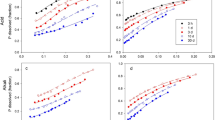Abstract
Methods of obtaining “reactive” phosphate rock residues from multicomponent phosphate fertilisers which contain soluble phosphorus components have been examined. Extraction using cold neutral ammonium citrate has been found to be more suitable than water, as chemical reactions appear to occur in water extraction solutions to modify the residue, and more impurity species such as calcium sulphate and iron and aluminium phosphates remain in the residues to complicate the process of obtaining reliable solubility figures.
“Deactivation” of the phosphate rock residues (as measured by decreased 2% formic acid solubilities) was found to be due to reactions occurring during the maturing process, and was dependent on the phosphate rock used, with North Carolina phosphate rock-based residues significantly affected, but Arad-based residues almost unaffected. However, for neutral ammonium citrate extractions, only North Carolina-based residues produced solubility figures lower than the original phosphate rock. Some selectivity of reaction in single superphosphate-“reactive” phosphate rock mixtures was indicated which further complicated assessment of the “deactivation” effect; however such an effect appeared to be much less significant than previously suggested.
Similar content being viewed by others
References
Bolan NS, Hedley MJ, Harrison R and Braithwaite AC (1990) Influence of manufacturing variables on characteristics and the agronomic value of partially acidulated phosphate fertilizers. Fert Res 26: 119–138
Braithwaite AC, Eaton AC and Groom PS (1992) Evaluation of double extraction techniques as solubility tests for fertiliser products containing phosphate rock components. Fert Res 31: 137–150
Braithwaite AC, Eaton AC and Groom PS (1990) Factors affecting the solubility of phosphate rock residues in 2% citric acid and 2% formic acid. Fert Res 23: 37–42
Braithwaite AC, Eaton AC and Groom PS (1989) Some factors associated with the use of the extractants 2% citric acid and 2% formic acid as estimators of available phosphorus in fertiliser products. Fert Res 19: 175–181
Charleston AG, Condron LM and Brown IWM (1989) The nature of residual apatites remaining after partial acidulation of phosphate rocks with phosphoric acid and sulphuric acids. Fert Res 18: 257–273
Junge A and Werner W (1989) Investigations on interactions of phosphorus compounds in partially acidulated phosphate rock and fertilizer effectiveness. Fert Res 20: 129–134
Resseler H and Werner W (1989) Properties of unreacted rock residues in partially acidulated phosphate rocks affecting their reactivity. Fert Res 20: 135–142
Stephen RC and Condron LM (1986) An assessment of the agronomic efficiency of partially acidulated phosphate rock fertilisers. Fert Res 10: 269–282
Author information
Authors and Affiliations
Rights and permissions
About this article
Cite this article
Braithwaite, A.C., Eaton, A.C. & Groom, P.S. Chemical effects in the assessment of phosphate rock residues extracted from multicomponent fertilisers. Fertilizer Research 32, 343–350 (1992). https://doi.org/10.1007/BF01050372
Received:
Accepted:
Issue Date:
DOI: https://doi.org/10.1007/BF01050372




